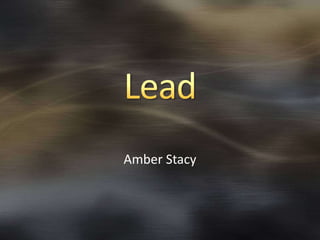
Lead
- 2. Basic Information: Atomic Number Atomic Symbol Atomic Weight Lead is a bluish-white metallic substance Very soft, malleable, & ductile Very poor conductor of electricity Pewter is one of many alloys of lead
- 3. Sources: Lead is primarily obtained from galena (PbS) by a roasting process Other common lead minerals are: Anglesite (PbSO4) Cerussite (PbCO3) Minim (Pb3O4) Native lead is extremely rare
- 4. Uses: Lead has a wide variety of Uses: (Includes both current & prior uses) Cable covering Batteries Plumbing Ammunition Manufacturing processes Insecticides Corrosive liquid containment Some crystal glass & flint glass Paints Sound absorption & sound proofing Radiation shield around X-ray equipment & nuclear reactors Gasoline
- 5. Health & Environmental Problems: Of the 74 lead isotopes, 4 are stable & the rest are radioactive Various forms of lead have various solubilities Major sources of lead exposure are: Lead in paint (inhalation or ingestion) Gasoline (inhalation) Automobile emissions (inhalation) Water, distribution systems, plumbing, & fixtures (ingestion) Food (ingestion) Lead poisoning is a global environmental & public health hazard both children & adults in every region of the world are being exposed to unsafe levels of lead in the environment Lead is a cumulative poison, which means is accumulates in the environment and bioaccumulates in living organisms
- 6. Extent of Threat: Major adverse impacts on public health are divided into 4 categories: Brain & nervous system damage including the mental development & impairment of children, as well as behavioral problems, learning disabilities, & hearing loss Reproductive system interference including premature births, low birth rates, impaired cell growth, & weakened bone & tooth development Circulatory system damage including oxygen absorption decrease , blood pressure increase, inhibition of hemoglobin production, & anemia Kidney malfunctioning, which can lead to gout, renal failure, blood poisoning (sepsis) , surprisingly hypertension, & of course death
- 7. Remediation: Lead & other heavy metals can be: Covered Buried Removed & recycled Moved to a safer location Transformed into a less toxic or inert form One of the most common remedies used worldwide for lead contaminated soils has been to mix the soils with chemical binders such as Portland cement, then to transfer the contaminated waste to a secure landfill site. However, this method is very expensive & is becoming an increasingly unacceptable solution
- 8. The End…That’s all folks!!